Porcelain stoneware for the kitchen floor: varieties, selection and care
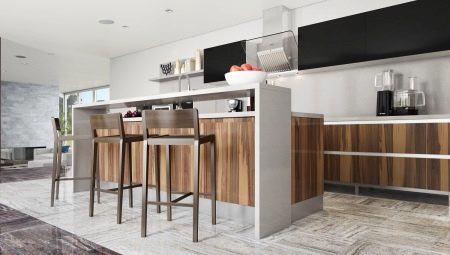
The choice of porcelain stoneware for the kitchen floor is a good solution to ensure the practicality and functionality of the coating. This material is highly durable, reliable and safe to use.
The large format of the modules is easy to install, moreover, in terms of its strength, porcelain stoneware is much superior to other types of coatings. Affordable cost, variety of design options, aesthetics and durability make such floors a truly profitable purchase. Let's take a closer look at how to choose the right material, what color solution to prefer, how to lay the tiles so that the floor looks stylish and not boring and trite.
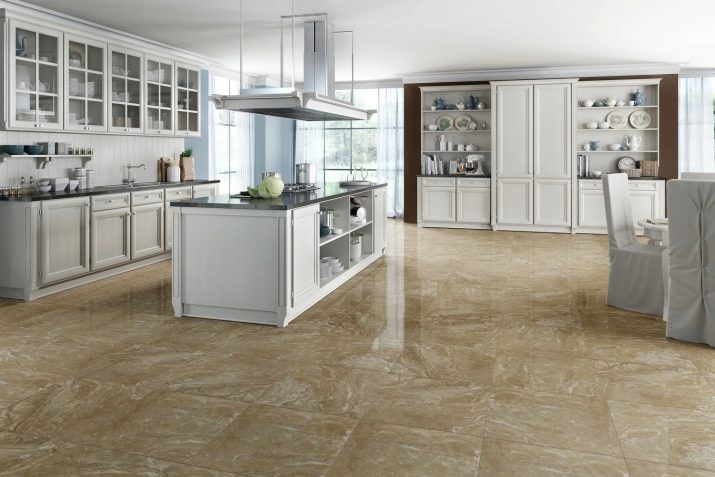
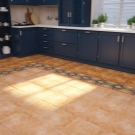
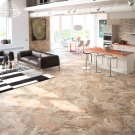
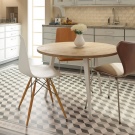
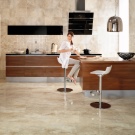
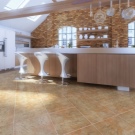
Peculiarities
Porcelain stoneware for the kitchen floor must meet a number of requirements to harmoniously place such a coating in the interior. This material is made using a technology similar to the production of ceramics. The composition includes mineral fillers - spar, sand, clay and natural coloring pigments. Acid colors and unnatural range of shades are not found in the collections of manufacturers of such coatings.
Porcelain stoneware is made by firing raw materials at a temperature of 1300 degrees Celsius and pressing, while the compression intensity is twice that of ordinary tiles.

As a result, the resulting material acquires a dense fine-pored structure and strength unattainable for conventional ceramics. The method of painting the coating is also different. In particular, pigments are added to porcelain stoneware at the stage of preparing the mixture, and it acquires the desired color throughout its entire thickness.
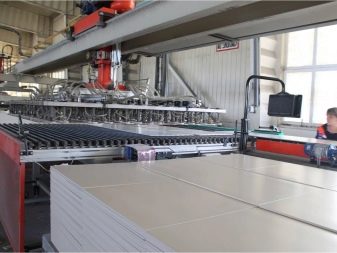
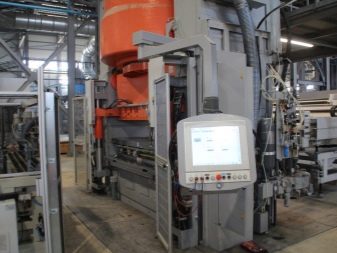
Among the characteristic features of porcelain stoneware, some properties can be noted.
- Low water absorption. Its indicator is only 0.05%, while the tile absorbs up to 10% moisture. Porcelain stoneware floors are not afraid of spilled water; in the event of an emergency drain from the washing machine or a leak in the sink, the risks of flooding the neighbors will be lower.
- Service life up to 100 years. Of course, porcelain stoneware has been produced for less than 50 years and this characteristic is subjective. Nevertheless, it is fully justified by calculations and test data.
- Resistance to different types of loads. Porcelain stoneware is not afraid of mechanical and shock effects, the surface wears out evenly. Subject to the rules of laying, it is impossible to split it even if a heavy cast-iron pan falls to the floor.
- Frost resistance and heat resistance. Such a coating can be put in the summer kitchen of a country house, it will withstand contact with hot coals from the fireplace.
- Environmental friendliness and safety. The use of completely natural raw materials excludes the release of potentially hazardous substances.
All these features make the porcelain stoneware floor for the kitchen quite a popular finishing option, used both in city apartments and in country houses.
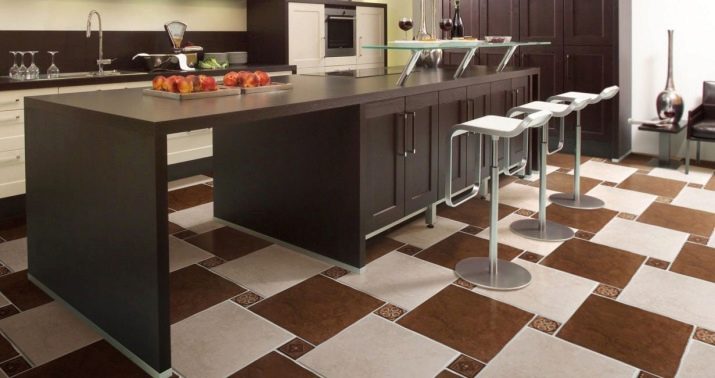
Views
All existing types of porcelain stoneware suitable for installation in the kitchen, can be categorized according to coating properties.
- Technical. As close as possible to granite in its characteristics. Cheap, durable, suitable for summer kitchens, unheated in winter.

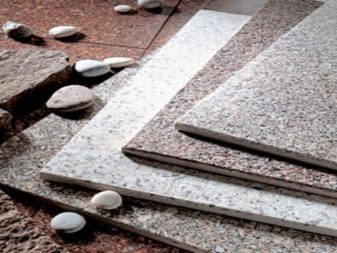
- Unprocessed. Tiles with a rough texture and matte surface. Suitable for work areas where it is important to avoid slipping. In terms of its hardness and moisture resistance, it is one of the best options, it has an affordable price.
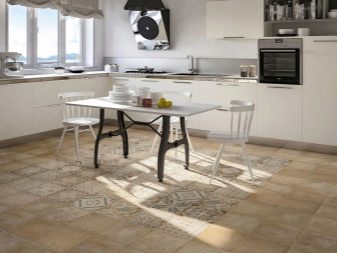

- Polished. Porcelain stoneware with a high gloss top layer. Visually appealing, but can be too slippery in the kitchen. In terms of its properties, it is inferior to analogs that have not undergone mechanical processing.

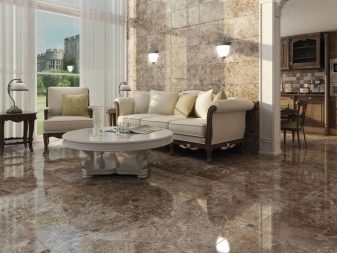
- Sanded. Reduced performance material, less durable.
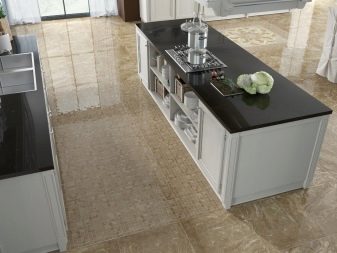
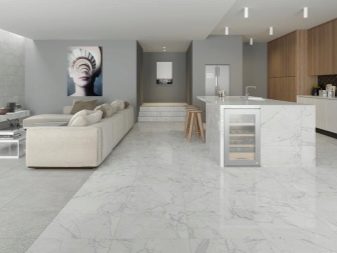
- Lappated or semi-matt. The surface has both smooth and sanded or rough areas.
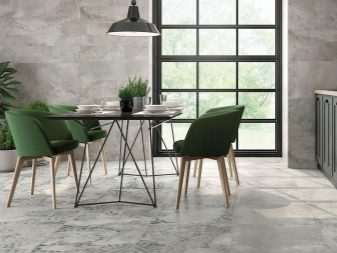
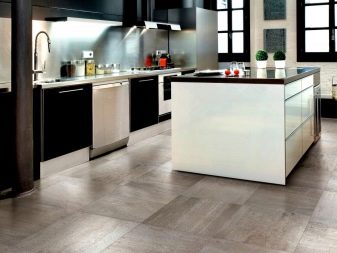
- Glossy, with a satin finish. It is similar to tiles in the method of creating a shiny layer - the outer coating is applied before firing. The finished coating has a pronounced shine.
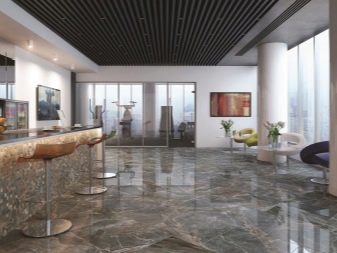
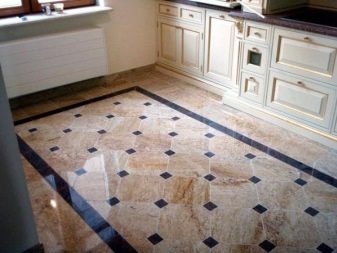
- Glazed. Porcelain stoneware covered with colored decorative glaze. The most varied in colors and decor, but the outer layer can quickly wear off.
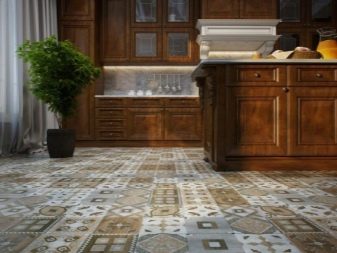
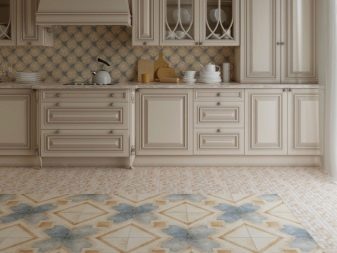
- Raised. Has a structure similar to natural stone. The coating is rough, with pronounced irregularities.
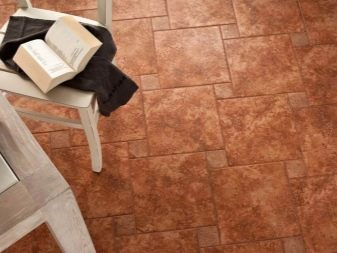
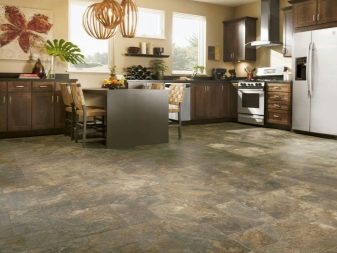
- Textured or structured. This type of porcelain stoneware recreates the surface of concrete, wood, metal, while retaining its properties. The surface of such a material does not slip.
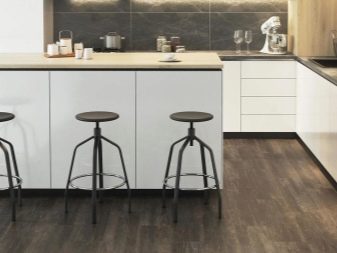
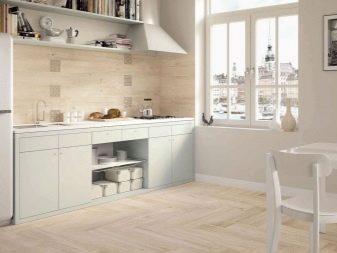
Dimensions (edit)
Standard size range of porcelain stoneware tiles implies the following gradation of square modules:
- 15 × 15 cm;
- 20 × 20 cm;
- 30 × 30 cm;
- 33 × 33 cm;
- 40 × 40 cm;
- 45 × 45 cm;
- 50 × 50 cm;
- 60 × 60 cm.
It is important to take into account that in the size of porcelain stoneware floor tiles, displacement up or down is allowed within the range of 3-7 mm.
Moreover, even in the same batch or package, these indicators will not be the same. Decorative inserts usually have side sizes from 5 to 10 cm, they are made in a square format.
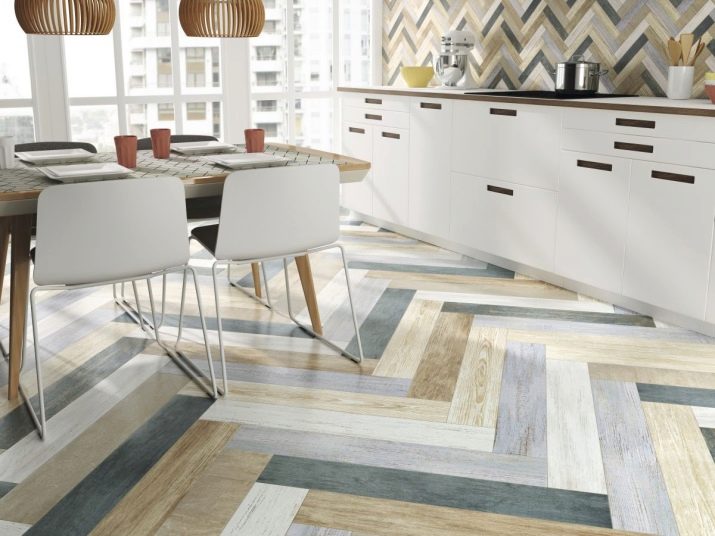
Besides, the category of textured porcelain stoneware, imitating parquet laying, stands out... In this category, you can find tiles in sizes 10 × 120 cm, 15 × 30 cm, 20 × 60 and 20 × 120 cm with a thickness of 8-11 mm. Thin products of 3 mm cut are not suitable for the floor, they are too fragile and cannot withstand intensive use. The largest thickness is 14-20 mm, such porcelain stoneware is used in areas with increased stress.
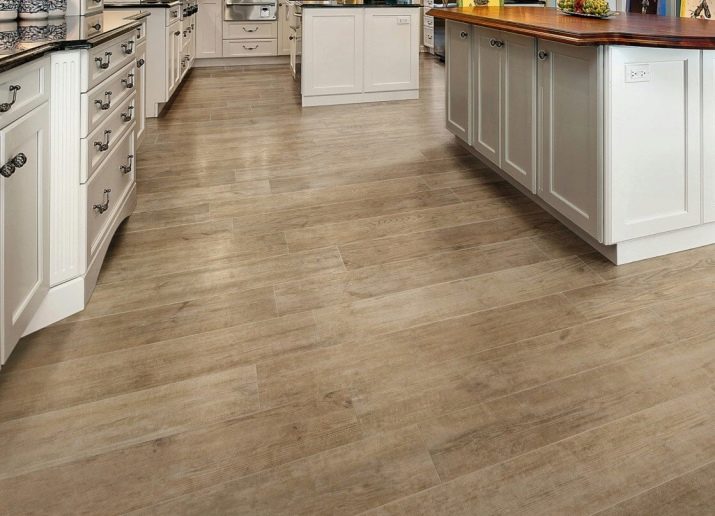
Color solutions
Porcelain stoneware used for finishing kitchen floors can have a variety of colors. When choosing the optimal color, you can build on the main gamut of the kitchen interior or choose options for contrasting design. In addition, it should be borne in mind that only matte porcelain stoneware gives an accurate color reproduction.
Glossy, glossy or structured coatings do not have such features and can lighten the color of the material.
Among the color solutions in the monocolouristic range, it is customary to distinguish 2 main groups.
- Chromatic or colored. These include all coatings that have a colored structure.
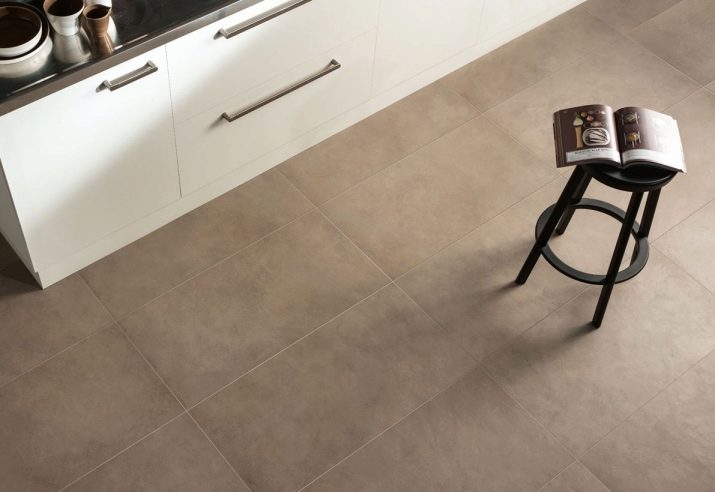
- Achromatic. These include white, gray, black colors, as well as their various variations from silver and graphite to ivory.
Such colors are uniform, do not have inclusions, streaks, unpainted areas, pronounced graininess.
These products can be glazed or made using classical technology.
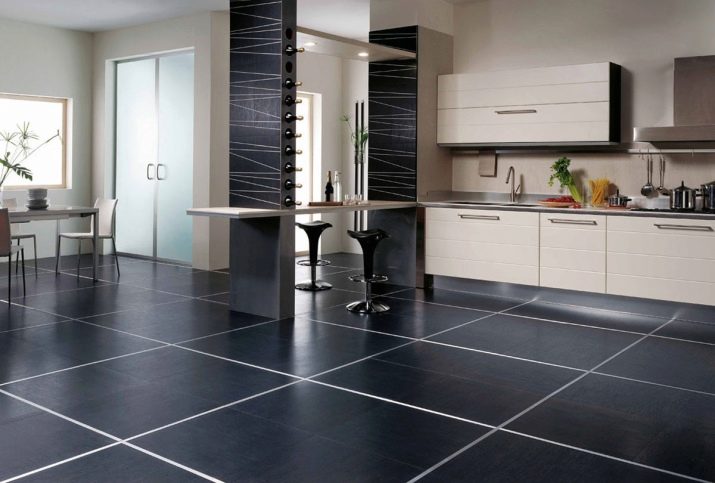
There are several options for multicolor solutions.
- Natural stone (most often marble). The material can have a polished or lapped surface, faithfully reproduces the colors and textures of a natural mineral, while being much more durable.
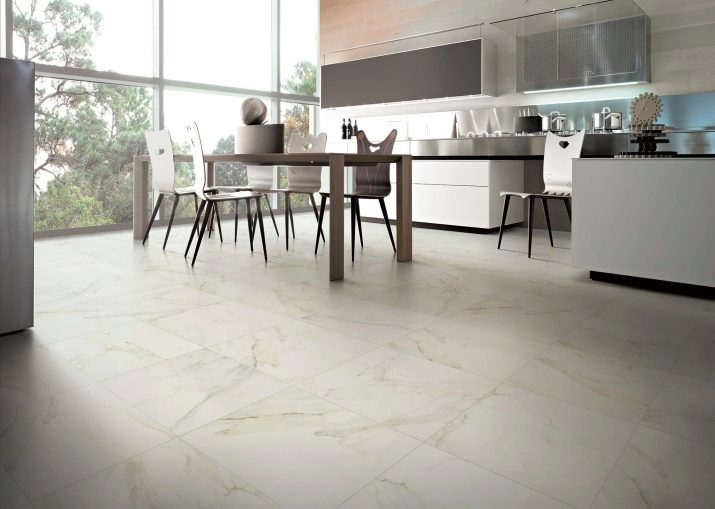
- Textured. With pronounced halftones, creating transitions of colors and shades. Such porcelain stoneware looks very decorative and attractive, most often the texturing technique is used when creating wood-like coatings.
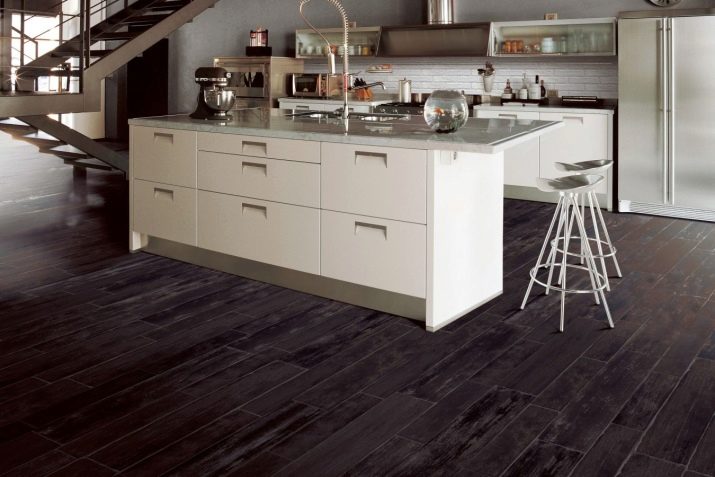
- Pepper and salt. A surface finish in which a mixture of dark and light blotches is uniformly coated. The basis is usually an achromatic range of tones or light beige shades. This color option looks the most noble in combination with a gray background.
When choosing a shade, it is important to remember that dazzling white tones in the kitchen look too active.
It is better to give preference to a milky tone or ivory. Gray and black colors are also relevant - they are quite neutral and go well with any style of decoration.
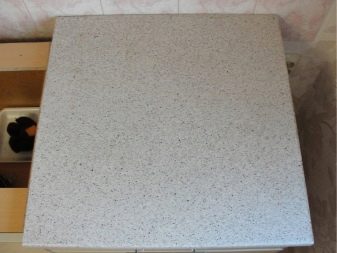
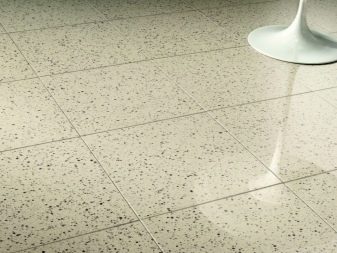
Design
When choosing a design for porcelain stoneware, it is important to understand that simple smooth tiles in the kitchen may look too strict. The optimal solution would be a not too slippery coating with a matte structure in saturated colors (blue, green, brown, yellow) with decorative inserts.
The alternation of black and white in the flooring looks interesting.
It is worth considering the use of coatings with a natural stone texture - black porcelain stoneware with white marble-like veins looks very aesthetically pleasing... In the loft style, you can pick up modules that simulate concrete. For country and scandi styles - with wood-like finish and parquet installation.
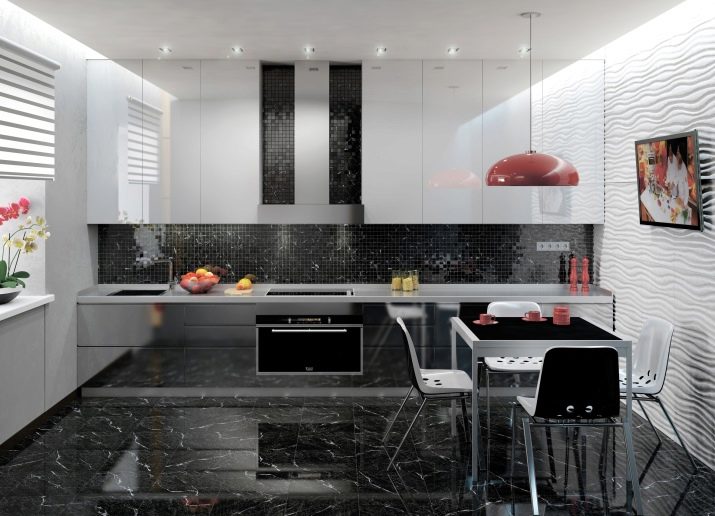
How to choose?
There are simple rules for choosing porcelain stoneware for laying in the kitchen. Pay attention to the correspondence between the area of the room and the size of the modules - it is better not to take tiles larger than 30 × 30 cm in a small kitchen. It is worth paying attention to the wear resistance class - it must be at least PEI 3.
Another important point - practicality... The best material would be a classic matte or textured version. Smooth mirror-shine tiles will easily turn a wet floor into a skating rink - it is better to leave it for the dining area.
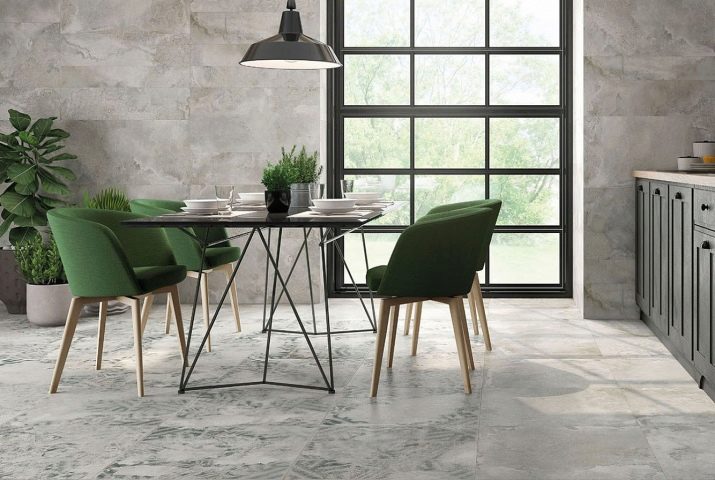
Styling options
There are different combinations of laying porcelain stoneware, but this coating can only be mounted on a very flat base - a concrete floor screed would be an ideal option.
According to the rules, there must be whole tiles on open for viewing areas of the floor. The clipped elements are placed at the edges where they will not be visible.
Among the popular options for laying porcelain stoneware on the floor in the kitchen are:
- traditional, straight line, suitable for any format;
- diagonally (for square slabs) at an angle of 45 degrees;
- staggered, offset by half of the module, as in brickwork;
- herringbone, allows you to imitate parquet;
- modular, with tiles of different sizes, laid according to a specific pattern.
In a small kitchen, it is better to use a straight transverse or modular installation. In a large kitchen, the diagonal version looks impressive.
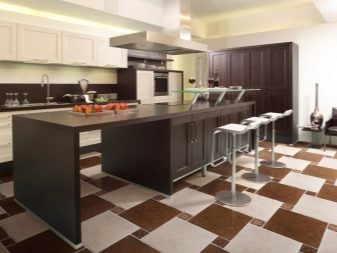
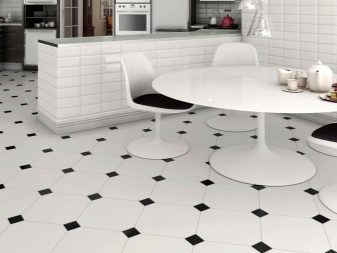

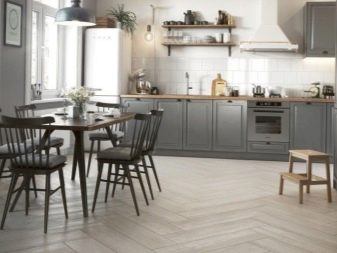
How to care?
The porcelain stoneware floor in the kitchen does not require particularly sophisticated maintenance. But there are a number of recommendations that can extend the life of the coating. It should not be washed with caustic acid products. - seams that are less durable than the base of the tile may suffer.
The use of abrasive chemicals should also be limited. Before wet cleaning, be sure to carry out dry cleaning - using a vacuum cleaner or a broom.
Grease stains, traces of tea, coffee, and other brightly colored liquids are removed from the surface of porcelain stoneware using alkaline compounds.
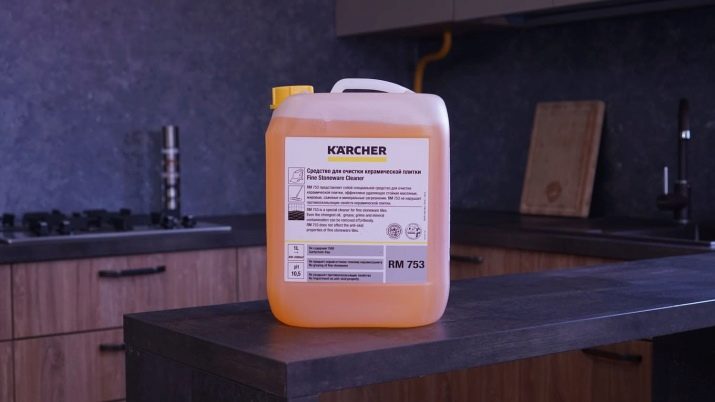
Traces of resin, bitumen, rubber are erased with acetone or other household solvent. Traces from construction or finishing work are removed with slightly acidic agents. It is recommended to additionally protect the kitchen floor from time to time with products based on synthetic wax or based on silicone and resins.

Beautiful examples
Various installation options allow you to make such tiles a stylish addition to the existing decor of the room - This is confirmed by various examples of beautiful combinations in the interior of the kitchen.
Stylish matt porcelain stoneware floor for a loft-style kitchen-dining room. The texture imitates a concrete surface.
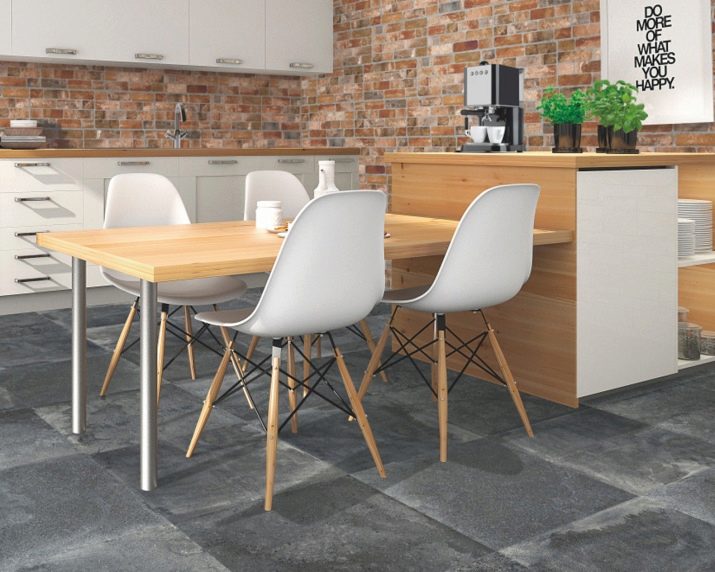
Porcelain stoneware floor with natural stone imitation. Laying apart looks interesting and not boring in the complex geometry of a large kitchen.

Porcelain stoneware in the finishing of the kitchen working area. The perfect laying and variegated texture of the tiles create the impression of a solid canvas.
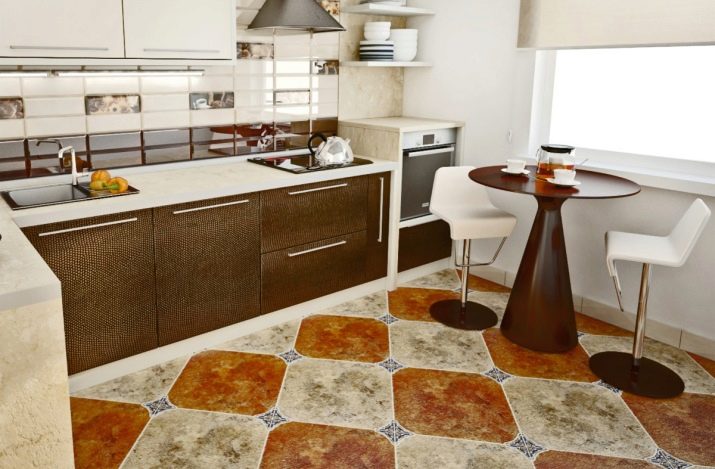
The following video will tell you how to choose porcelain stoneware.


